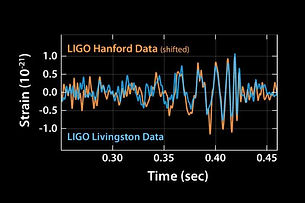
Lecture 1. Martin Hendry
Lectures slides available here: Full Lecture
Email: Martin.Hendry@glasgow.ac.uk
Part 1: “Gravitational-Wave Astronomy: Opening a New Window on the Universe”
Gravitational waves are ripples in spacetime, produced by the most violent events in the cosmos: exploding stars, colliding black holes, perhaps even the Big Bang itself. Since September 2015, when the twin LIGO (Laser Interferometer Gravitational-Wave Observatory) instruments made the first-ever direct detection of gravitational waves from the merger of two massive black holes more than a billion light years distant, the LIGO Scientific Collaboration and their colleagues in the Virgo Collaboration have reported the confirmed detection of ten further compact binary mergers, including the merger of two neutron stars detected in August 2017 that was also observed across the entire electromagnetic spectrum. Moreover since April 2019 the LIGO and Virgo detectors have been engaged in their third observing run, with enhanced sensitivity, and during the first four months of “O3” they reported a further 22 candidate detections. The gravitational-wave window on the cosmos is now well and truly open!
In this workshop I will introduce the basic physical principles that underpin the detection of gravitational waves, explaining how the shape of the gravitational waveforms that we have detected can tell us about the physical properties of the sources that produced them, and how can use that information to study the universe. I will then use some of the real LIGO Virgo data and software freely available on the Gravitational Wave Open Science Center to illustrate some key aspects of how gravitational-wave data analysis works in practice, and what it has told us so far about the nature of black holes and neutron stars – and more generally about astrophysics and cosmology.
Recommended software download:
Part 2: “Studying Fundamental Physics and Cosmology With Current and Future Gravitational-Wave Observations”
2019 has been a special year in the history of general relativity, as it marks 100 years since the expeditions to Sobral in Brazil and the African island of Principe to observe the total eclipse of 29 May 1919 – which provided the first successful observational test of Einstein’s theory of gravity and its prediction of the bending of starlight passing close to the limb of the Sun. In this lecture, I will bring the story of testing GR up to date by reviewing the latest LIGO and Virgo observations of the mergers of binary black holes and neutron stars – and how these observations are shaping and improving our understanding of strong gravity, cosmology and fundamental physics.
I will then outline the gravitational-wave “roadmap” for the coming decades, including the planned LIGO and Virgo observing runs and upgrades, the addition of KAGRA and LIGO India to the ground-based network, the “ third generation” ground-based interferometers proposed for the 2030s and the enormous potential of spaceborne detectors like the LISA satellite, set for launch in 2034. I will describe how these, and other, observations should provide a much deeper and more complete view of the Gravitational Universe over the next two decades, offering new and complementary insights into a wide range of astrophysical questions – from the origin of black holes and the evolution of galaxies to the nature of dark matter and dark energy and perhaps even the fundamental properties of spacetime itself.
Lecture 2. Paolo Salucci
Lectures slides available here: Coming soon
Email: salucci@sissa.it
Dark Matter, the last Frontier?
We have a strong and beautiful knowledge of laws of Physics, With our instruments we witness the beginning and the evolution of the universe. We are able to model how galaxies, star and planes have been formed. Our observations extend space, time and wavelenghts. However, I will show that the main actors of all this, the dark energy and dark matter, totally escape our coemprehension. As regard to the latter, I will show its complex, but extraordinally well ordered structure. I also will reveal how the phenomenon of Dark Matter be so vast and intriguing that it calls for a change of paradigm on how we approach the Nature. We must reverse engeneering observations related to the properties of dark matter in galaxies in order to get the actual theory of the dark particle that, I'll argue, cannot be accessed by first principles arguments . Finally, the current scenario for dark matter particle and several new possible ones will be discussed. .
Also check the review entitled "The distribution of dark matter in galaxies" (and references therein).



